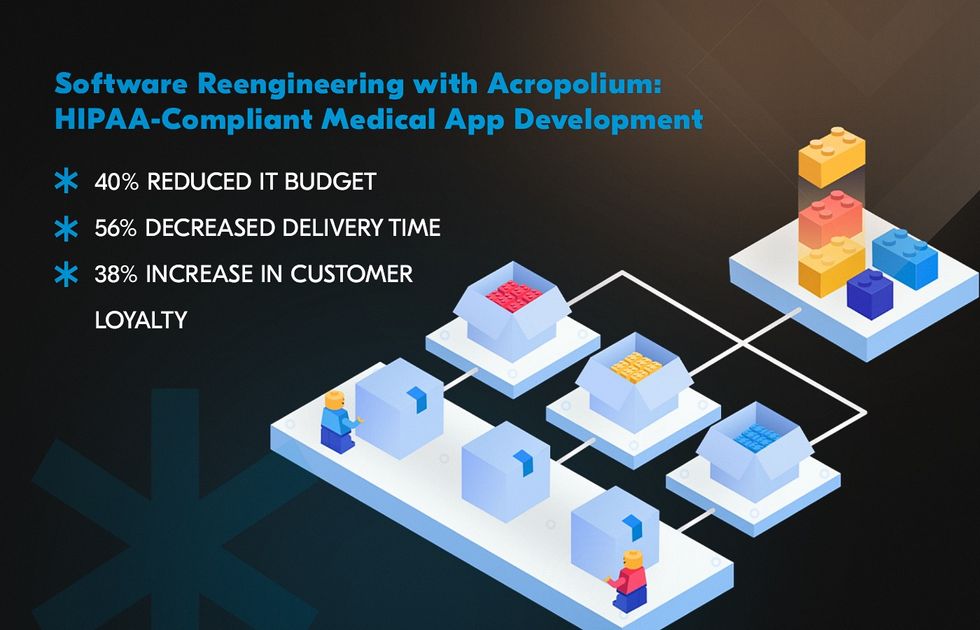
Key takeaways
- Application reengineering is updating and improving existing software systems to meet business requirements.
- The most common ways to upgrade software are rehosting, rewriting, and rebuilding.
- You should modernize your software if your existing software is outdated, expensive to maintain, has compliance issues, or fails to meet current business needs.
The wheels of progress never stop turning, so the existing digital product may eventually stop matching your business needs. Software reengineering becomes a must if your system isn’t efficient enough, doesn’t withstand the competitive market, or is simply too expensive to maintain.
Upgrading the existing system is quite challenging. If your legacy code performance could be better or you want to expand your platform, finding a development team that will offer you an efficient solution may be hard.
Acropolium has 20 years of experience developing custom software and modernizing legacy technology. We have cooperated with dozens of industries, including highly regulated healthcare and fintech. All this has helped us accumulate enough experience to provide you with an in-depth analysis in this post.
What is Software Reengineering?

Software reengineering is a complex process aimed at enhancing and updating legacy software systems to make them more suitable for current and future requirements. It involves a comprehensive analysis and transformation of the existing software to address limitations and improve performance.
It’s more cost-effective to improve an existing system than to build a new one from scratch. However, making substantial changes to existing software can introduce new issues. Proper risk management and testing are critical to minimize the impact of these risks. Also, you must ensure that the system can adapt to changing market conditions and customer demands.
Ways To Upgrade Your Software
The Application Modernization Services market is set to grow from around $21.7 billion in 2022 to roughly $50.4 billion by 2028, at an annual growth rate of 15.1%. This growth is due to more businesses using cloud technology and upgrading their software to utilize mobile, cloud, analytics, social, and cognitive advancements.

Why are companies turning to cloud services? The latter are flexible and can update old systems and support remote work. Modernizing applications also makes businesses more agile and productive, improving user experiences, speeding up product launches, and saving money through cloud computing and data analytics.
There is no one-size-fits-all option when looking for the right way to upgrade your software. To understand how to change your existing system, you should examine your case and determine the scale of the problem. Most likely, you will be choosing between the three most common solutions. You may rehost, rewrite, or rebuild your legacy software.

Each of these options can be either highly beneficial or misleading. So, before upgrading the code, make sure you’ve chosen the right direction.
Rehosting
Software rehosting perfectly suits the systems that require rapid data migration. Your legacy code leaves its original hardware and moves to a more modern and well-functioning one. The rehosting option for cloud migration can address the costly software maintenance issue. Besides, many prefer this approach since it’s fast, straightforward, and cost-efficient.
The primary use case of the rehosting solution is when your on-premise platform is unaffordable and difficult to maintain. Cloud solutions allow you to expand your capabilities and modernize the software capability without changing the system itself. Your employees won’t have to learn how the new software works. Furthermore, cloud services offer reliable and secure data storage.
However, if your legacy code is ineffective, rehosting won’t help. In this case, it would rather be a temporary solution.
Rewriting
Rewriting is an option when your legacy code fails to perform its functions properly. Each app has its logic behind the software architecture. So it’s quite complicated to improve it, keeping consistency and adding the required features.
Rewriting cannot be completed automatically. It requires a deep immersion into your business environment. Developers will also need to translate databases and add or remove certain features. This process is accompanied by testing software at all stages, building roadmaps, and providing detailed business analytics.
In case of success, your application will be fully operational, preserving and enriching the original idea.
Software Rebuilding
If you want to update outdated software, rehosting or rewriting your system won’t address the issue. In contrast, rebuilding can bring your app back into the game.
Legacy code rebuilding begins with an in-depth study of your business, current needs, and goals. The developers’ team should find the weak points of the existing solution. They decide whether to leave some parts or to rebuild everything from scratch. Of course, partial rebuilding is a much more cost-efficient option.
Software reengineering solutions give a unique chance to improve user experience, interface design, update the tech stack, and add new features. Finally, you will get completely updated software that will still perform its critical functions.
Reasons to Rebuild Software

According to Gartner Inc., 91% of CIOs indicated that legacy programs causing technical debt influence agility and delivery speed. And this is not the whole list of threats. Let’s take a closer look at each of these issues.
Lower Maintenance Costs
Old systems require significant investment in technical support, including maintenance fees, labor costs, hosting hardware expenses, etc. Over the last few years, new hosting and cloud solutions such as the SaaS model are likely to address this issue.
Cloud migration is the best way to save your software and databases without rebuilding the entire system. Move to a more convenient and cost-efficient solution with a subscription model.
Better Compliance
Many existing systems weren’t built in compliance with specific regulations, such as GDPR and HIPAA. These restrictions are majorly related to the personal data privacy requirements that your software should meet. You can use this opportunity by migrating your databases to the cloud or reengineering outdated software solutions to the SaaS model.
Modern Tech Stack
The outdated tech stack’s developers community is often not large enough. Therefore, finding good specialists for your legacy software maintenance and optimization may be challenging. Rebuilding your application with a more relevant and future-proof technology could be much more efficient than looking for developers to update the old one.
Competitiveness
Your business should keep up with the latest trends and offer users up-to-date services. If your existing software doesn’t meet your core business goals and slows down the company’s development, it’s time to change it.
3 examples of successful software reengineering implementation

- To modernize its systems and reduce time to market for new applications, PayPal switched to the Go programming language. This allowed for clean, efficient, and easily scalable code. Go not only supports network and multi-core computing but also provides high speed.
- UPS used Agile and DevOps concepts to modernize its outdated package tracking system. They used an iterative, agile approach, breaking the project into small tasks. Successive updating of the interface of the mobile and desktop versions made it possible to make a viable product, reducing customer churn and personnel costs.
- Walmart is reengineering its supply chain by greater use of data, more intelligent software, and automation. It enhances in-stock, inventory accuracy, and in-store shopping, pickup, and delivery efficiency. Walmart aims to have around 65% of stores and 55% of fulfillment centers serviced by automation by the end of 2026.
Software Rebuild Process

The tactic for rebuilding software entirely depends on your case. However, there are some typical stages of the reengineering process.
Build New Software Architecture
The root of the whole system is the legacy app’s architecture and logic. If you decide to rebuild your software, it requires an in-depth analysis of the existing architecture. Studying it will give an understanding of how to reconstruct the system. The new architecture will be based on your current needs.
The developers must investigate the client’s business, including its audience, core goals, and objectives. Thus, they can create an architectural solution that will address the former system’s issues and determine which elements and features should be implemented, replaced, or removed.
Define Scope of Work
The scope of work for software re-engineering solution depends on a few key factors. Firstly, the developers need to estimate if the system needs complete rebuilding or partial replacement of the original legacy code. Secondly, they need to find the right solutions for each goal. It contains the choice of the tech stack, backend solutions, updating databases, etc. Finally, it’s possible to calculate the approximate timeline and cost of software rebuilding.
These three most common reengineering approaches define the project’s scope.
- Implementing the new tech stack or facilitating software maintenance with no drastic changes in the system’s functionality.
- Using rebuild as a chance to add new required functions to optimize the system’s functionality.
- Rebuilding the entire system from scratch by modernizing every single piece of outdated software.
Prepare New Software UX\UI Design
Redesign is an essential part of the software reengineering process. Usability and interface design are the core components of a satisfying user experience and convenient software environment. Modern UI/UX design trends include overall consistency, minimalism, and custom interface elements adapted to users’ needs. Designers should tailor the application to new requirements and refresh the UI. They have to suggest solutions to make the interface intuitive and easy to navigate.
Break Up A Monolithic Software Into Modules
The traditional approach to legacy software architecture uses a monolith code base. It means that all modules are deployed together and depend on each other. Such a solution is not reliable and difficult to scale. If one module stops working, you will need to change the entire system.
Microservices architecture enables breaking up monolithic software into separate modules, developed and deployed independently. Such a system will be much easier to maintain. Splitting monolith software into microservices can be achieved by turning to cloud services. The developers’ team will separate APIs, databases, and other layers into independent modules.
Update Databases
Your existing legacy software stores certain data that should be well-protected and accessible to certain user groups. Reengineering your system should be followed by consistent database updates.
There are two possible approaches to accomplish this task:
- Keeping your databases in the existing storage and sharing them with the modernized system.
This approach may be cheaper and less time-consuming. However, your current data-storing solution may be as outdated as the software. If the service is unreliable or too expensive to maintain, it would be wise to choose another option.
- Moving your database to the new storage.
Modern businesses often choose cloud solutions that are more secure and cost-efficient. They use a ready-made service instead of building a new in-house solution. BaaS offers scalable database management for processing data and secure storage.
Test Your New Software
During the software reengineering process, test your software as often as possible. QA specialists should check every change for sustainability and compliance with your business goals. Planning and analytical mistakes may cause serious problems or even the entire project’s failure. So it’s highly recommended to build and test prototypes involving real users.
Challenges of Rebuilding Software

When you hire a developers’ team to reengineer legacy software, they may face many challenges that need certain expertise to cope with. Here are the most typical issues and the possible ways to address them.
Maintain Old Project
Your old software maintenance might be too costly and ineffective. Furthermore, it’s often hard to find a developers’ team that will be ready to support your system with an outdated tech stack. Refusing from on-premises software solutions and turning to cloud-based ones may save up to 40% of the cost you would spend on in-house backend development.
Educate Users to New Interface
Businesses often need to change the entire system architecture or some part of it to rebuild software. However, users might need help getting used to it after the new system is out and learning how it works. So if you change your software environment, the redesigned interface should be clear and intuitive. Providing users with clear onboarding and familiar navigation will facilitate their adaptation to the new system.
Save Data in DB
Some companies may find it easier to keep their databases in the existing storage and transfer access to the new system. But, in many cases, old data storage systems are insecure. Hence, the attempt to save costs will be unjustified.
Cloud migration and alternative solutions such as BaaS are much more cost-effective and time-saving than building a new backend from scratch.
Our Experience
For 20 years, we at Acropolium have dealt with numerous software re-engineering & migration projects. Our dedicated developers gained experience in rebuilding outdated systems, including technical software audit, full or partial modernization consulting, complete system reengineering, cloud-based solutions, code refactoring, and platform migration.
We update systems for very different industries. They include transportation & logistics, hospitality, healthcare, oil & gas, building & construction, risk management, automotive, fintech, retail, marketing & events, etc.
The following case study may bring you useful insights into software modernization’s challenges, goals, and results.
HIPAA Compliant Medical App Development

We developed this project for an American virtual healthcare company focused on the sexual health market. The challenge was to examine, improve, and rewrite the existing legacy code. Thus, we had a goal to improve the code quality and optimize the system for further scaling.
Our developers did their best to understand each module’s function and create the required documentation. We managed to optimize the code and infrastructure. Furthermore, our team developed the functions that enabled the required compliance with HIPAA regulations.
As a result, the IT budget and the delivery time were reduced by more than 40%, while the customer loyalty was increased by 38%.
Rebuild Your Software
The need to re-engineer your software may emerge for many different reasons. Some of the most common ones are high maintenance costs, system obsolescence, and compliance issues. Depending on your case, the ways to modernize your existing software may vary. But all of them lead to a single destination. Your system should start working properly, obtain all the necessary functions, and meet your business goals. There are numerous challenges on the way to improvement. However, the main difficulty is to hire the right team that will manage to find a perfect solution.
We at Acropolium have sufficient expertise in modernizing various systems, with more than fifty successfully completed projects. So whether you need to rebuild custom software or rewrite the legacy code, feel free to ask any questions. Get in touch with our dedicated team, and we will find the best solution to modernize your system!









![ᐉ Banking Legacy Systems: [Modernization Strategies for the Financial Industry]](/img/articles/banking-legacy-systems/img01.jpg)

![Migrating from Monolith to Microservices: [Strategy & 2025 Guide]](/img/articles/migrating-monolith-to-microservices/img01.jpg)


